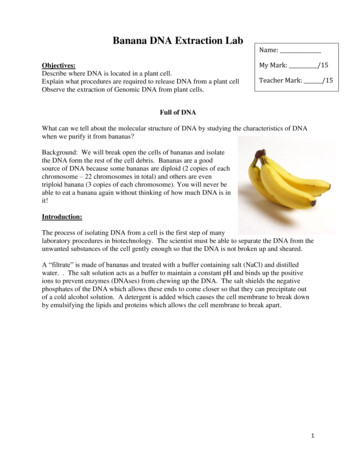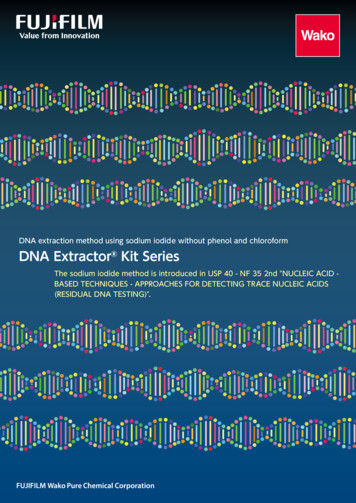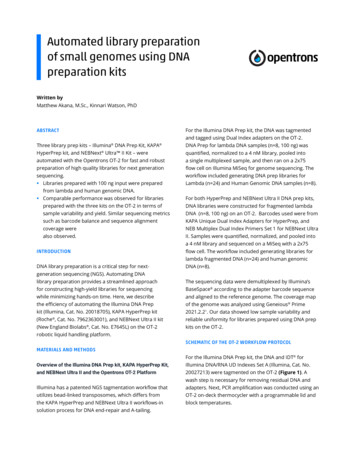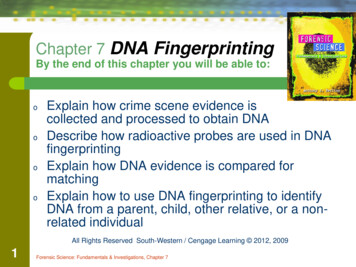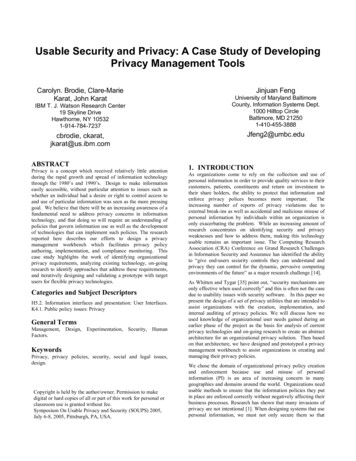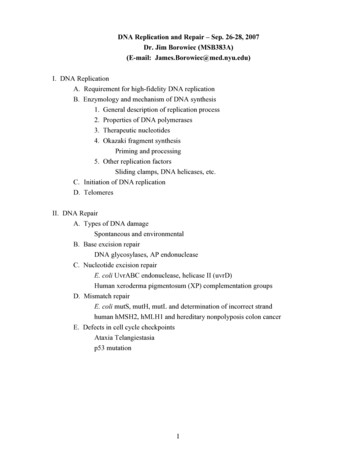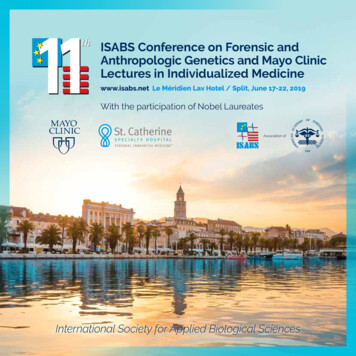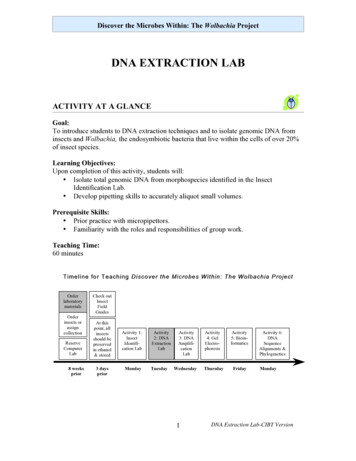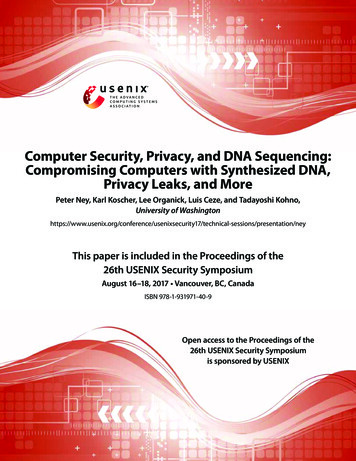
Transcription
Computer Security, Privacy, and DNA Sequencing:Compromising Computers with Synthesized DNA,Privacy Leaks, and MorePeter Ney, Karl Koscher, Lee Organick, Luis Ceze, and Tadayoshi Kohno,University of security17/technical-sessions/presentation/neyThis paper is included in the Proceedings of the26th USENIX Security SymposiumAugust 16–18, 2017 Vancouver, BC, CanadaISBN 978-1-931971-40-9Open access to the Proceedings of the26th USENIX Security Symposiumis sponsored by USENIX
Computer Security, Privacy, and DNA Sequencing:Compromising Computers with Synthesized DNA, Privacy Leaks, and MorePeter Ney, Karl Koscher, Lee Organick, Luis Ceze, Tadayoshi KohnoUniversity of .washington.eduAbstractThe rapid improvement in DNA sequencing hassparked a big data revolution in genomic sciences, whichhas in turn led to a proliferation of bioinformatics tools.To date, these tools have encountered little adversarialpressure. This paper evaluates the robustness of suchtools if (or when) adversarial attacks manifest. Wedemonstrate, for the first time, the synthesis of DNAwhich — when sequenced and processed — gives an attacker arbitrary remote code execution. To study thefeasibility of creating and synthesizing a DNA-basedexploit, we performed our attack on a modified downstream sequencing utility with a deliberately introducedvulnerability. After sequencing, we observed information leakage in our data due to sample bleeding. Whilethis phenomena is known to the sequencing community,we provide the first discussion of how this leakage channel could be used adversarially to inject data or revealsensitive information. We then evaluate the general security hygiene of common DNA processing programs,and unfortunately, find concrete evidence of poor security practices used throughout the field. Informed by ourexperiments and results, we develop a broad frameworkand guidelines to safeguard security and privacy in DNAsynthesis, sequencing, and processing.1IntroductionDNA sequencing costs have dropped exponentially, outstripping Moore’s Law since 2008, primarily driven byadvances in next-generation sequencing (NGS) technologies. For example, Illumina’s cost to sequence the human genome dropped from around 100,000 in 2009 tojust 1,000 in 2014 [39]. These advances have revolutionized genomic sciences, accelerating the pace of newdiscoveries in areas such as cancer biology and epidemiology.Our research suggests that DNA sequencing and analysis have not to date received significant — if any — adversarial pressure. The key question that motivates ourUSENIX Associationresearch then, is the following: How robust will the DNAsequencing and processing pipeline be if or when adversarial pressures manifest? This line of inquiry raises related questions, such as: Are DNA-based attacks possible? What potential consequences could occur if anadversary compromises a component of the DNA processing pipeline? How serious might those consequencesbe? Since DNA sequencing is rapidly progressing intonew domains, such as forensics and DNA data storage [2, 9, 10, 15, 17], we believe it is prudent to understand current security challenges in the DNA sequencingpipeline before mass adoption.The modern DNA sequencing and analysis pipeline islarge, complicated, and computationally-intensive. DNAis pre-processed in a wet lab and analyzed with a highthroughput sequencer (itself a computer) that performsimage analysis. It is then common to conduct a widerange of computational tasks with the raw output fromthe sequencer using many software utilities. We seek toassess the overall state of this pipeline in general, andto experimentally explore key aspects that are not represented in traditional computing systems: DNA samples.Exploiting Computer Programs with DNA. TheDNA processing pipeline begins with DNA strands ina test tube. Hence, we start our security explorationsfrom this point. Namely, we first experimentally evaluatewhether it is possible to compromise a computer programusing physical DNA.Our exploration of this question lead us to synthesizeDNA strands that, after sequencing and post-processing,generated a file; when used as input into a vulnerable program, this file yielded an open socket for remote control.We elaborate on specifics in Section 3.To the best of our knowledge, ours is the first example of compromising a computer system using biologicalor synthetic DNA samples. Our exploit did not target aprogram used by biologists in the field; rather it targetedone that we modified to contain a known vulnerability.26th USENIX Security Symposium765
Our use of such a trojaned program was consistent withthe primary focus of the first research phase to understand — and overcome — challenges posed by creatingan exploit at a physical level. For example, our initial exploit contained too few C and G nucleotides (we reviewDNA background in Section 2) to synthesize the DNAstrand; therefore, we modified our exploit to overcomethis challenge. Our key finding is that it is possible to encode a computer exploit into synthesized DNA strands.Side-Effect — Information Leakage. Although not agoal, our efforts to experimentally evaluate the abilityto synthesize adversarial DNA resulted in our observing an information leakage channel. Standard practicemultiplexes different samples on the same sequencingmachine. The methods to multiplex (and later demultiplex) DNA samples can leak information between samples during sequencing. Our exploit sample was sequenced and multiplexed in this manner alongside samples from another research team. We noticed that our sequencing results contained DNA sequences derived fromtheir samples.Other biologists have observed these effects [16, 19,25, 27, 33], but their concerns focused on experimentalaccuracy, not on security or information leakage. Fromour perspective we use these unanticipated results toguide a security discussion of information leakage inherent in the DNA sequencing pipeline.Software Security Awareness Throughout thePipeline. Having demonstrated the ability to exploit acomputer program with synthesized DNA, we next evaluated the computer security properties of downstreamDNA analysis tools. We analyzed the security of 13commonly used, open source programs. We selectedthese programs methodically, choosing ones writtenin C/C . We then evaluated the programs’ softwaresecurity practices and compared them to a baseline ofprograms known to receive adversarial pressure (e.g.,web servers and remote shells).We found that existing biological analysis programshave a much higher frequency of insecure C runtime library function calls (e.g., strcpy). This suggests thatDNA processing software has not incorporated modernsoftware security best practices. However, rather thanrely solely on heuristics, we took the next step and determined whether we could target static buffers to causeprogram crashes. We readily found three buffer overflowvulnerabilities. Given the prevalence of poor softwaresecurity practices and the well-known fact that programcrashes can often be converted to exploits, we chose notto convert each program crash into a working exploit.Threat Model and Guidelines. When exploring atechnology domain new to computer security, any individual study lacks the breadth to address the entire do-76626th USENIX Security Symposiummain. For example, early work on the attack surface ofmodern automobiles considered only one vehicle and afew example attacks [7, 20]. However, as the first workto explore a domain, an important contribution can involve drawing inferences from concrete results and domain knowledge to define broader lessons and extrapolate threat models for the entire domain, as others didfor the modern automobile [7]. Leveraging our technical results and multidisciplinary backgrounds (computer security, synthetic biology, and the design and useof the DNA processing pipeline), we drew inferencesto present a threat model and recommendations for theDNA sequencing and processing pipeline and the associated community.Summary. To our knowledge, our research is the firstto consider computer security implications of the modernDNA sequencing pipeline. Our four key contributionsinclude: We demonstrate, for the first time, the ability tocompromise a computer program with sequencedDNA. In so doing, we encountered challenges whensynthesizing DNA strands containing exploits anddeveloped methods to overcome those challenges. We observe a side channel resulting from fundamental properties of DNA sequencing technologies,and we pioneer the exploration of how one mightexploit this side channel for adversarial purposes. We evaluate the software security in a wide set ofDNA processing programs and find that they do notadhere to modern security best practices (e.g., theyfrequently use insecure function calls and containbuffer overflow vulnerabilities). We derive a threat model for the DNA sequencingpipeline and present recommendations to offset potential attacks.2Biology and DNA Sequencing: BackgroundOur work strives to apply computer security principlesand perspectives to a new field: genomic sciences, andspecifically, DNA synthesis, sequencing, and analysis.To do so, we offer a basic review of the biological, chemical, and computational processes in this field.2.1DNADeoxyribonucleic acid (DNA) is the carrier of genetic information for all known living organisms. It is composedof an alternating sugar-phosphate backbone to whicha sequence of four possible nucleotides (also calledbases) are linearly attached. These nucleotides — adenine, thymine, cytosine, and guanine — are commonlyabbreviated as A, T, C, and G, respectively. Each nucleotide bonds with its complement — A with T, and CUSENIX Association
with G. Sequencing is the process of reconstructing theoriginal order of nucleotides in a DNA sample.While DNA can form many structures, the mostcommon is double-stranded DNA (dsDNA), where twostrands with complementary base sequences bond toform the well-known double helix structure. DNA’ssugar-phosphate backbone causes its strand ends to beasymmetric: The phosphate end, called the 50 end, andthe sugar end, called the 30 end. By convention, nucleotide sequences are read from the 50 to the 30 end.Many traditional lab protocols require DNA strands tobe replicated (also called amplification). Amplificationuses a technique called polymerase chain reaction, orPCR. dsDNA is first melted at high temperatures to separate its two strands. The temperature is then lowered,and primers (synthesized strands typically 20 nucleotideslong) anneal (reattach) to the complimentary ends of theDNA strands. At slightly higher temperatures, DNApolymerase (an enzyme that synthesizes DNA), attachesto these end regions where the primer has annealed andproduces a complimentary copy of the original strand.This process is repeated as needed to exponentially amplify DNA.2.2Next-Generation DNA SequencingNext-generation sequencing (NGS) systems differ fromprior sequencing methods in that they read relativelyshort sequences, called reads, but in a massively parallel fashion. Longer DNA strands are sequenced byrandomly cleaving DNA into shorter sequences, readingthese sequences in parallel, and reconstructing the original, longer sequence. Several different types of NGSsystems do this work; among the most popular are thevarious Illumina sequencers, which are based on a technique known as sequencing by synthesis.Before sequencing a typical genomic DNA samplewith an Illumina sequencer, the DNA sample must bemanually processed in the lab. It is cleaved into shortsequences of a few hundred bases and amplified usingPCR. Special DNA adapter sequences are then attachedto both ends of the amplified DNA. This double-strandedDNA sample is separated into single-stranded DNA andapplied to a glass flow cell. The adapter sequences attached to the sample fragments bind to complementaryfragments on the flow cell surface. The bound sequenceslocally replicate to produce clusters of identical DNA,called clonal clusters.The DNA in each clonal cluster is sequenced in rounds(called cycles) by appending a complementary fluorescently labeled nucleotide to the single-stranded DNA ineach clonal cluster. Each time a new fluorescent base isadded to the strand, it emits a particular color specific toeach base (e.g., A, C, G, and T). The cluster sequence isobtained by imaging the flow cell in each cycle and not-USENIX Associationing the fluorescent color each cluster emits. The numberof cycles determines the length of resulting reads (oftenbetween 150-300 bases). These identified bases added ineach cycle, called base calls, are written out to per-cyclebase call files. A separate utility then takes these filesand converts the reads into a standard text-based formatcalled FASTQ.FASTQ files are the de facto standard for exchanging next-generation sequencing results. Their structureis simple: each read has an ASCII header identifying theread source, followed by a line with the sequence writtenas an ASCII A, C, G, or T. Reads additionally contain aseparator line, followed by a line with ASCII charactersencoding the quality or confidence of each base call.2.3Downstream ProcessingThe raw FASTQ files that come directly from the sequencer are rarely useful by themselves, and extensive downstream processing and analysis is usually performed after sequencing. This processing is typicallydone in phases by dedicated programs; the output from aprogram in one stage is sent to a program in a later processing stage. This section describes some commonlyused downstream processing steps, which we explore forsecurity vulnerabilities in Section 6.Before analyzing the sequence reads, an initial preprocessing phase occurs where by the reads (stored ina FASTQ files) are cleaned up to remove undesired ones.The last base calls in a read often have lower qualityscores, so it is common to truncate the reads to a fixedlength when the score drops below a defined threshold. DNA sequences from unintended sources — like theadapters used to bind sample DNA to the flow cell orcontrol sequences used to verify sequencing accuracy —need to be removed from the sequence file. Other preprocessing steps merge paired-end reads if there is overlap, convert different quality score file formats, or compress FASTQ files for archival purposes.Direct output from a sequencer contains only shortchunks of reads derived from the full sequence, and in noparticular order. These unordered reads can be mergedby aligning them to a reference sequence (e.g., the human genome) if one exists, or they can be merged fromscratch, using overlaps in the reads to stitch them together in a method called de novo assembly. When using a reference sequence, the alignment of each read inrelation to the reference is stored in a text based format (SAM) or a compressed representation (BAM). Bothmethods, especially de novo assembly, are computationally and memory intensive and may be run on computerclusters if the size of the sample to reconstruct is sufficiently large (e.g., a mammalian genome).After the sequence has been aligned or assembledmore work may remain, and the following are but a26th USENIX Security Symposium767
promise that system. As one might predict, significantunknowns exist. Can DNA itself compromise a computer system, or does something in the DNA sequencing pipeline make such attacks impossible? Prior to ourwork, to the best of our knowledge, there has never beena demonstrated DNA-based exploit of a computer system. Indeed, without concrete, experimental evidence,it is impossible to know whether DNA-based computercompromises are purely hypothetical or a real possibility. We therefore seek to experimentally answer the previously unexplored question:Can DNA be used to compromise a computer?Figure 1: Our synthesized DNA exploitfew examples of the widely varied analysis methodscommonly used. It is customary to look for variationsbetween the sample and some reference for biologically meaningful differences (e.g., genetic variations thatcause disease). Specific variations in the sequenced sample are usually stored in a plain text file (VCF) so redundant sequencing information can be discarded. NGStechniques are also used in more complicated biological assays to analyze RNA (RNA-seq) or protein-DNAinteractions (ChIP-seq). In these cases, the samples’ sequence are not only valuable, but the number and preciselocation of its reads in relation to a reference sequenceare also meaningful.2.4DNA SynthesisSynthetic DNA, commercially produced via phosphoramidite chemistry, is characterized by nucleotides attached to one another with specific reagents to form specified sequences. The resulting length, quality, and costvaries greatly depending on the method of reagent delivery, the substrate on which DNA is synthesized, andconsumer specifications. For example, Integrated DNATechnologies (IDT) synthesis of a custom gene utilizestheir “gBlock” service, which differs in capabilities andconstraints from their “custom oligo” service designedfor shorter strands (oligos or oligonucleotides are shortDNA sequences commonly used in genetics). The costfor these two services varies significantly depending onthe length of the strand ordered, the degree to whichDNA must be washed, or whether there are DNA modifications (e.g., fluorescent tags).3Compromising a Computer with DNADNA, in its most basic form, stores data. Conceptually,if DNA were used as input to a computer system, anopen issue is the possibility that it could be used to com-76826th USENIX Security SymposiumTo answer this question, we seek an end-to-end experimental evaluation of an exploit. Namely, we seek tomimic an adversary and (1) synthesize a real, biological DNA sequence with a malicious, embedded exploit.We then seek to experimentally evaluate the impact ofthat exploit DNA on a victim by having the victim (2)sequence that DNA using standard sequencing methodsand (3) post-process the DNA sequence with a realisticprogram — a program that a scientist might use to analyze the resulting DNA sequence. If the exploit is successful, step (3) should result in arbitrary code executionon the victim computer.This section explores the biological nature of this attack pipeline — how to encode an exploit into DNA suchthat, when sequenced, will hijack execution when processed by the victim program. We therefore intentionallychose to create our own vulnerable program for step (3),i.e., a program inspired by actual bioinformatics toolsbut with an obvious vulnerability. In Section 6, we consider the security of the sequencing pipeline in general.Our results suggest that while our exploited program inthis section is vulnerable to a basic buffer overflow exploit, the security hygiene of the overall DNA sequencing pipeline is not much better.Despite challenges, this section demonstrates that it ispossible to create DNA that, when sequenced and processed, compromises a victim system. See Figure 1 fora photo of our DNA exploit. In conducting this work,we identified and overcame multiple challenges, whichwe describe — along with methods for overcoming themand the resulting lessons — below.3.1Target ProgramThe FASTQ compression utility, fqzcomp, is designed tocompress DNA sequences. For experimental purposes,we inserted a vulnerability into this utility. To do so,we first copied fqzcomp from https://sourceforge.net/projects/fqzcomp/ and inserted a vulnerabilityinto version 4.6 of its source code; a function that processes and compresses DNA reads individually, usinga fixed-size buffer to store the compressed data. ThisUSENIX Association
a) 0x10(%rsi)movb allcallsite:callcallback.string "/bin/sh"b) Binary 8FFFF73DEADFFc) DNA-Encoded Exploit90908907484831C0FF68EFDEFF90 90.76 0848 8989 F78D 76DB 480F 052F 6200 .BE AD.7F 00d) Failed Synthesis TGTTGGGTCTCTGGACCTGAATTTTTTTTTTTTCTTTFigure 2: Our initial, unsuccessful exploit attemptmodification lets us perform a buffer overflow with alonger than expected DNA read in order to hijack control flow. While the use of such a fixed-size buffer isan obvious vulnerability, we note that fqzcomp alreadycontains over two dozen static buffers. Our modificationsadded 54 lines of C code and deleted 127 lines fromfqzcomp.Our modified fqzcomp version used a simple 2-bitDNA encoding scheme. The four nucleotides were encoded as two bits — A as 00, C as 01, G as 10, and T as11 — packing bits into bytes starting with the most significant bits.We ran the target program in a simplified computing environment and disabled common security features.Specifically, we disabled stack canaries and ASLR, andwe marked the stack as executable.We stress that our target modified program has aknown, and in some sense trivial, vulnerability. We alsostress that its environment is in many ways the “best possible” environment for an adversary. For experimentalpurposes, however, we believe that these conditions areacceptable for the following reasons. First, our primarygoal is to understand the issues unique to DNA-encodedexploits. Second, as we relate in Section 6, we find thatthe general security hygiene of bioinformatics programsis very low, with prevalent usage of fixed-size buffers,strcpy, and so on. Finally, we note that genome sequencing processes are rapidly improving: since earlyNGS machines read sequences on the order of 50-100bases, a fixed-size buffer in that range may have beenacceptable years ago. Today, any fixed-size buffer wouldlikely be vulnerable, as new longer read sequencing technologies can produce reads that are upwards of 60,000bases [30]. These newer sequencers lack the throughputof short-read counterparts and are not at present commonly used; Illumina short-read sequencers now haveover 90% market share [18]. Future technological improvements will likely make long-read sequencers moreviable in the future.USENIX Association3.2Creating and Synthesizing an ExploitWe now turn to our design of a DNA strand that, whensequenced, exploits the vulnerable target program. Ourkey goal was to identify potential challenges. Our effortshere were successful in two regards. First, we identifiedseveral challenges, including limitations on the exploit’ssize and type and problems inherent in the DNA synthesis process that constrained the sequences we couldgenerate. Second, by overcoming these challenges, wefound that it was possible to create a DNA sequence thatcould in fact compromise a program.Our process was iterative. We created exploits thatwe thought would work, surfaced challenges, and theniterated on improved exploits.We initially encoded one of the most straight-forwardexploits, i.e., overwriting the return instruction pointeron the stack to point back into shellcode from AlephOne’s “Smashing the Stack for Fun and Profit” [26]. Wemade minor modifications to port the shellcode to the 64bit Linux syscall interface. To simplify exploit testing,we used a stripped-down version of the vulnerable program that simply compressed a single DNA read into afixed-size buffer. Our shellcode was 55 bytes long, withanother 39 bytes of padding needed for cache line alignment and saved registers. We filled this space with NOPsand bogus saved register values (0xdeadbeef). The resulting exploit, 94 bytes long, was encoded as 376 nucleotides. Figure 2 shows this process.We submitted this sequence to the IDT gBlocks synthesis service, which creates synthetic gene fragments upto 3,000 bases long. Unfortunately, at this step we facedour first challenges. Our sequence contained many issuesthat prevented IDT from being able to synthesize our order: The NOP sled produced a repetitive sequence(GCAA) near the start of our sequence, which contributed to more than 69% of the sequence. Repetitive sequences can cause difficulties in sequencingand may cause the physical strand to fold in on itself or form other secondary structures because ofDNA’s complementary nature.26th USENIX Security Symposium769
e) FASTQ Filea) Shellcodesh &/dev/tcp/degdeg.com/9 0 &1c) Synthesized Exploitd) DNA Sequencingb) DNA-Encoded ACCAAAGTGTTAGGGTACTTCCAGCTTCGTTCGf ) Exploited Utility@NB501203:50:HHNT7AFXX:1:11101:2573:1030 CTAAGACCAAAGTGTTAGGGTACTTCCAGCTTCGTTCGA EEEEEEEEEEEEEEEEEEEEEEEEEEEEEEEEEEEEE EEEEEE EEEEEAEAAEEEEEAEE EEEEAEEEEEEEEEAEEEE EEE EEEEAE E EE E EE/ E/EAE EEEEEEEAA EE6AAE.g) Reverse Shell CallbackFigure 3: Our working exploit pipeline The negative offset JMP created a run of 13 consecutive Ts. Long runs of the same base, called homopolymers, can be difficult to accurately synthesize. The gBlocks service limits homopolymers tono more than nine As or Ts and five Gs or Cs. The repeated 0xdeadbeef bytes produced a long(40 base pair) repetitive sequence. The NOP sled resulted in low GC-content near thebeginning of the sequence. Cs and Gs physicallybind together more tightly than As and Ts and thusadd stability to the DNA strand. Typically, each20-base window must have 25 to 75 percent GCcontent. The first and last 20 bases of a sequenceare even more constrained since they must have 40to 60 percent GC-content to be synthesized. A 20 base pair window containing the 13 basepair homopolymer did not meet the minimum GCcontent threshold.Another challenge we faced was the length of our exploit. Our Illumina NextSeq sequencer is rated for amaximum of 300 base pair reads, while the IlluminaMiSeq is rated for a maximum of 600 base pair reads.We addressed these challenges by making our targetprogram and exploit designs more sophisticated. To minimize the number of homopolymers introduced by largepointers and offsets, we switched to targeting the 32-bitx86 instruction set architecture (ISA). We also reducedthe buffer size in our target program to minimize the required size of our sequence. Since our ultimate goal wasarbitrary remote code execution, we investigated swapping out Aleph One’s simple shellcode, which simplyspawns a local shell, with one that provided a reverseshell over TCP. We explored the shell-storm.orgarchive for a suitable example; however, even the mostcompact shellcode was too long to fit inside a sequencethat could be reasonably sequenced by the NextSeq sequencer.Our second exploit attempt uses an obscure featureof bash, which exposes virtual /dev/tcp devices thatcreate TCP/IP connections. We use this feature to redirect stdin and stdout of /bin/sh to a TCP/IP socket,which connects back to our server. We combined this77026th USENIX Security Symposiumtactic with a return-to-libc attack that calls system(), resulting in a 43-byte exploit, shown in Figure 3. We useda short, fully qualified domain name we controlled aswell as a single digit port number to keep exploit lengthas short as possible. While we considered obtaining asmaller FQDN (e.g., r.sh) to keep our exploit size assmall as possible, we hypothesized that we could successfully sequence our 176-base1 DNA strand with ourIllumina NextSeq despite exceeding its recommendedsingle-ended read size.Since the bulk of this exploit consists of lowercase letters, whose two most significant bits were 01 in ASCII —or encoded as a nucleotide, C — we got an acceptablelevel of GC-content throughout the exploit. The one exception was near the original port number — 3 (encodedas ATAT) — which we changed to 9 (encoded as ATGC) tomaintain a minimum level of GC-content. This sequencewas accepted by the IDT gBlocks service with no errorsor warnings. IDT’s retail cost to synthesize of up to 500base pairs was 89 USD.As is standard for NGS runs, our sample was taggedand extended with a unique index (GCCAAT, in ourcase) and co-sequenced with other experiments. The sequencer was configured to perform 177 non-index readcycles; this is the typical configuration used by anotherresearch group that manages the sequencing machine andwas sufficiently long to contain the 176 base pair exploitsequence within a single read.The sample was sequenced on all four lanes (physically separate portions) of the flow cell. After demultiplexing by indices, there were four separate FASTQ files(one for each lane) together containing 811,118 reads.We processed the four FASTQ files separately, whichis done to account for lane-specific errors. We filtered outlow-quality reads that did not identify one or more bases;these bases appear as Ns (representing an unknown base)in the FASTQ file. We provided the filtered FASTQ filefrom the first lane to our modified fqzcomp program,which immediately called back to our server, giving us1 A bug in our DNA encoding program repeated the final byte, whichunnecessarily extended our exploit by four bases, but otherwise did notaffect our results.USENIX Association
arbitrary remote code execution via a bash shell.3.3Exploit ReliabilityThe exploit was not robust to errors in sequencing; a single miscalled base would break the exploit.
guide a security discussion of information leakage inher-ent in the DNA sequencing pipeline. Software Security Awareness Throughout the Pipeline. Having demonstrated the ability to exploit a computer program with synthesized DNA, we next eval-uated the computer security properties of downstream DNA analysis tools. We analyzed the security of 13
